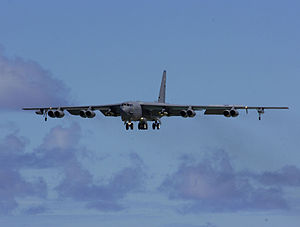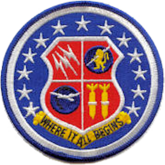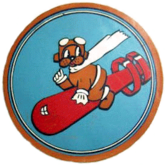| 329th Combat Crew Training Squadron | |
|---|---|
 B-52 Stratofortress as flown by the squadron B-52 Stratofortress as flown by the squadron | |
| Active | 1942-1971; 1986-1994 |
| Country | |
| Branch | |
| Role | heavy bomber training |
| Motto(s) | Universal Air Enforced Peace and Law (1956-1971) Where it All Begins (1986-1994) |
| Engagements | European Theater of Operations Mediterranean Theater of Operations |
| Decorations | Distinguished Unit Citation Air Force Outstanding Unit Award |
| Insignia | |
| 329th Combat Crew Training Squadron emblem |  |
| World War II squadron emblem |  |
| World War II fuselage code | RE |
The 329th Combat Crew Training Squadron is an inactive United States Air Force unit. It was last assigned to the 93d Operations Group at Castle Air Force Base, California, where it was responsible for the training of Boeing B-52 Stratofortress aircrews until inactivating on 1 July 1994.
The squadron was first activated as the 329th Bombardment Squadron in 1942 and trained with Consolidated B-24 Liberator heavy bombers. During training, it also flew antisubmarine patrols over the Gulf of Mexico. It was one of the first bomber units to deploy to the European Theater of Operations, to participate in the strategic bombing campaign against Germany. In 1942 and 1943, its air echelon moved to reinforce the bomber force in the Mediterranean Theater of Operations, where it earned a Distinguished Unit Citation for its participation in Operation Tidal Wave. Following V-E Day, the squadron returned to the United States to retrain as a Boeing B-29 Superfortress unit.
In 1946, the squadron moved to Castle Field, which was to be its home for the rest of its existence. It trained for bomber operations and also conducted the flying phase of B-52 aircrew training until inactivating in 1971. It was reactivated at Castle in the training mission in 1986 as the 329th Strategic Bomber Training Squadron.
History
| This section does not cite any sources. Please help improve this section by adding citations to reliable sources. Unsourced material may be challenged and removed. (May 2021) (Learn how and when to remove this message) |
World War II

Established in early 1942 initially as a Consolidated B-24 Liberator reconnaissance squadron, flying antisubmarine patrols. Later being redesignated as a heavy bomb group; trained under Third Air Force in Florida. Completed training in late 1942; deploying to European Theater of Operations as one of the initial heavy bomber squadrons assigned to VIII Bomber Command in England, September 1942.
Engaged in long-ranger strategic bombardment operations over Occupied Europe. Deployed to IX Bomber Command in Egypt in December 1942; operating from airfields in Libya and Tunisia. Raided enemy military and industrial targets in Italy and in the southern Balkans, including the Nazi-controlled oilfields at Polesti, Romania receiving a Distinguished Unit Citation for its gallantry in that raid. Also flew tactical bombing raids against Afrika Korps defensive positions in Tunisia; supporting British Eighth Army forces in their advance to Tunis, in September and October 1943.
Returned to England with disestablishment of IX Bomber Command in North Africa. From England, resumed long-range strategic bombardment raids on Occupied Europe and Nazi Germany, attacking enemy military and industrial targets as part of the United States' air offensive. The squadron was one of the most highly decorated units in the Eighth Air Force, continuing offensive attacks until the German capitulation in May 1945.
Post war bomber operations
Having returned to the United States in June 1945; being re-manned and re-equipped with Boeing B-29 Superfortress heavy bombers. Trained for deployment to the Central Pacific Area to carry out very long range strategic bombing raids over Japan. Japanese capitulation in August canceled plans for deployment, instead became Continental Air Command (later Strategic Air Command) B-29 squadron.
Began upgrading to the new Boeing B-50 Superfortress, an advanced version of the B-29 in 1950. The B-50 gave the unit the capability to carry heavy loads of conventional weapons faster and farther as well as being designed for atomic bomb missions if necessary. By 1951, the emergence of the Soviet MiG-15 interceptor in the skies of North Korea signaled the end of the propeller-driven B-50 as a first-line strategic bomber. Received Boeing B-47 Stratojet jet bombers in 1954, and in 1955 began receiving early model of the Boeing B-52 Stratofortress. The squadron ceased operations on 14 September 1971 and inactivated at the end of the month.
Bomber crew training
Reactivated as a B-52 combat crew training squadron in 1986; inactivated in 1994 after the end of the Cold War and the reduction of the B-52 fleet.
Lineage
- Constituted 329th Bombardment Squadron (Heavy) on 28 January 1942
- Activated on 1 March 1942
- Redesignated: 329th Bombardment Squadron, Heavy on 20 August 1943
- Redesignated: 329th Bombardment Squadron, Very Heavy on 23 May 1945
- Redesignated: 329th Bombardment Squadron, Medium on 28 May 1948
- Redesignated: 329th Bombardment Squadron, Heavy on 1 February 1955
- Inactivated on 30 September 1971
- Redesignated 329th Strategic Bombardment Training Squadron c. 12 February 1986
- Activated on 1 July 1986
- Redesignated 329th Combat Crew Training Squadron c. 1 July 1987
- Inactivated on 1 July 1994
Assignments
- 93d Bombardment Group, 1 March 1942 (attached to 93d Bombardment Wing after 10 February 1951)
- 93d Bombardment Wing, 16 June 1952 – 30 September 1971
- 93d Bombardment Wing, 1 July 1986
- 93d Operations Group, 1 September 1991 – 1 July 1994
Stations
|
|
Aircraft
- Consolidated B-24 Liberator, 1942–1945
- Boeing B-29 Superfortress, 1945–1949
- Boeing B-50 Superfortress, 1949–1954
- Boeing B-47 Stratojet, 1954–1955
- Boeing B-52 Stratofortress, 1955–197, 1986–1994
See also
References
Notes
- Explanatory notes
- Approved 25 April 1956
- A Bombardment Squadron, Provisional, 329th was organized at Anderson Air Force Base, Guam on 1 June 1972 and assigned to the Strategic Wing, Provisional, 72d, operating B-52s deployed from bases in the United States. It was inactivated on 15 November 1973. This provisional unit is not related to the 329th Combat Crew Training Squadron despite its similar name.
- Citations
- ^ Maurer, Combat Squadrons, pp. 405-406
- ^ Watkins, pp. 38-39
- Ravenstein, p.130
- ^ Lineage, including assignments, stations, and aircraft, through May 1963 in Maurer, Combat Squadrons, pp. 405-406
- Assignments through June 1977 in Ravenstein, p.130
- ^ Station number in Anderson
- Mueller, p. 75
Bibliography
![]() This article incorporates public domain material from the Air Force Historical Research Agency
This article incorporates public domain material from the Air Force Historical Research Agency
- Anderson, Capt. Barry (1985). Army Air Forces Stations: A Guide to the Stations Where U.S. Army Air Forces Personnel Served in the United Kingdom During World War II (PDF). Maxwell AFB, AL: Research Division, USAF Historical Research Center. Archived from the original (PDF) on 23 January 2016. Retrieved 7 July 2012.
- Maurer, Maurer, ed. (1983) . Air Force Combat Units of World War II (PDF) (reprint ed.). Washington, DC: Office of Air Force History. ISBN 0-912799-02-1. LCCN 61060979.
- Maurer, Maurer, ed. (1982) . Combat Squadrons of the Air Force, World War II (PDF) (reprint ed.). Washington, DC: Office of Air Force History. ISBN 0-405-12194-6. LCCN 70605402. OCLC 72556.
- Mueller, Robert (1989). Air Force Bases, Vol. I, Active Air Force Bases Within the United States of America on 17 September 1982 (PDF). Washington, DC: Office of Air Force History. ISBN 0-912799-53-6. Retrieved 17 December 2016.
- Ravenstein, Charles A. (1984). Air Force Combat Wings, Lineage & Honors Histories 1947-1977 (PDF). Washington, DC: Office of Air Force History. ISBN 0-912799-12-9. Retrieved 17 December 2016.
- Watkins, Robert (2008). Battle Colors: Insignia and Markings of the Eighth Air Force In World War II. Vol. I (VIII) Bomber Command. Atglen, PA: Shiffer Publishing Ltd. ISBN 978-0-7643-1987-7.
External links
| United States Air Force | |||||||||||
|---|---|---|---|---|---|---|---|---|---|---|---|
| Leadership |  | ||||||||||
| Structure |
| ||||||||||
| Personnel and training | |||||||||||
| Uniforms and equipment | |||||||||||
| History and traditions |
| ||||||||||
- The 93rd Bombardment Group Museum, Station 104, Hardwick. A small museum on the actual airfield site in Nissen (Quonset) and brick built huts.
